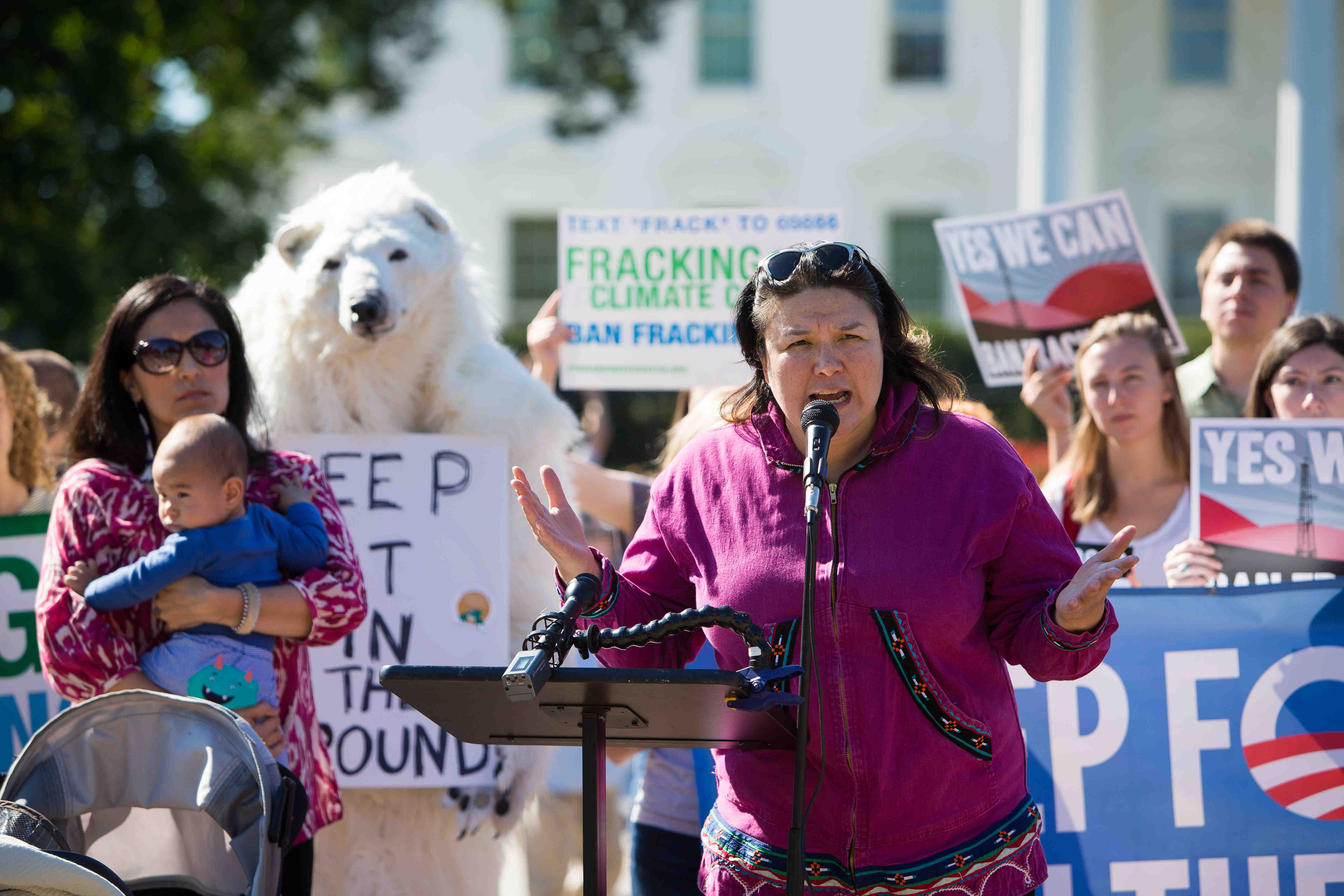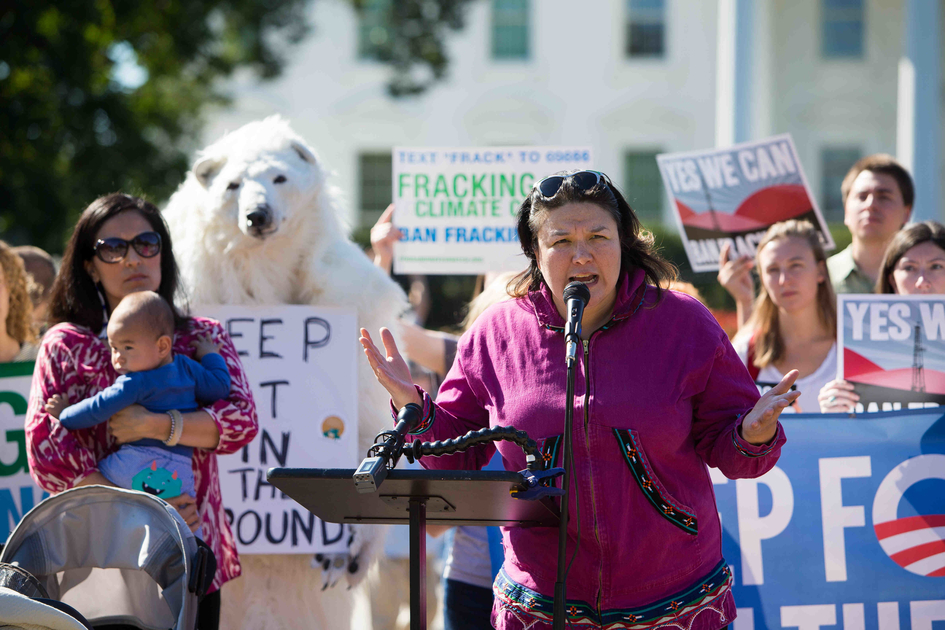This case study was written by Tom Goldtooth, Executive Director of Indigenous Environmental Network for our latest bank report card, Banking on Climate Change: Fossil Fuel Finance Report Card 2018.
 A coalition of more than 400 organizations and leaders deliver a historic letter to the White House calling on President Obama to stop new federal fossil fuel leasing on public lands and oceans in the United States.
A coalition of more than 400 organizations and leaders deliver a historic letter to the White House calling on President Obama to stop new federal fossil fuel leasing on public lands and oceans in the United States.
Alaska Native rights and Indigenous sovereignty cannot be separated from the problem of extreme oil and gas production in Alaska. Politicians and oil interests have a long history of pushing legislation nullifying Alaska Native land claims, especially those claims that stood in the way of oil and pipeline development.
After being declared a state in 1958, Alaska selected for oil development tracts of land on the North Slope, in an area called Prudhoe Bay.1 Without consultation and consent of the local Inupiat village, but with approval of the U.S. Bureau of Land Management, these lands were transferred to the state.2
In 1964, the state leased some of these tracts to oil companies and in 1968, oil was discovered at Prudhoe Bay.3 The oil boom forever altered the ecosystem and the life of the Inupiat people, including by contributing to climate change through the release of carbon from oil sent from the North Slope to refineries. This all led to the building of the 800-mile Trans-Alaska pipeline across the state that further trampled over the rights of Inupiat peoples and Alaska Native land rights at large.4
The Alaska Native Claims Settlement Act (ANCSA) was passed in 1971, over opposition from the Inupiat.5 ANCSA took land from jurisdictional control of Alaska Natives, allowing the petroleum industry and State of Alaska to gain access to oil reserves.6
Native Alaskans are once again confronted with oil and gas expansion under the Trump administration, with potential oil drilling in the Alaska Outer Continental Shelf (OCS) and opening of the Alaska National Wildlife Refuge (ANWR) to oil and gas development.7
In April 2017, Trump signed an executive order lifting a ban on oil exploration in the coastal seas of Alaska. The U.S. government is now proposing 19 offshore lease sales in the Chukchi Sea, the Beaufort Sea, Cook Inlet, and other areas.8 Any oil spills in these Arctic waters would be catastrophic for bowhead whales, seals, polar bears and other marine mammals, and would directly affect the Alaska Natives’ subsistence culture and way of life.9 Spills or drilling disasters would mean high-risk cleanup challenged by ice cover, subzero temperatures, and harsh weather conditions. There is no proven way to clean sea ice of oil from potential spills.10
The U.S. Republican tax overhaul law passed in December 2017 included a provision requiring two oil and gas lease sales in the coastal plains area of the ANWR over the next 10 years.11
ANWR is one of the world’s most pristine and beautiful ecosystems, with landscapes and wildlife that demand the strongest protection. The Refuge is home to porcupine caribou, muskoxen, moose, Arctic fox, lynx, wolves, and polar bears, brown bears and black bears, and is a stopping point for nearly 200 species of migratory birds.12
For Alaska Natives, such as the Gwich’in Athabascan peoples, protecting the Refuge and the caribou they depend on is a matter of human rights and the collective right of Indigenous peoples – as well as a critical matter of survival.13 In opposing Arctic oil drilling, they are fighting for their rights and the rights of the porcupine caribou, whose calving grounds are within the coastal plain of the Refuge. The Gwich’in call these caribou calving grounds Iizhik Gwats’an Gwnadaii Goodlit: “the sacred place where life begins.” The Gwich’in have followed the caribou herd across the lands of this protected Refuge for thousands of years.14 They are rightfully concerned that seismic exploration and drilling for oil in the Refuge will have disastrous effects on the delicate web of life in these sacred lands. Oil and gas expansion in ANWR would carve up the Refuge with roads and industrial infrastructure, fragmenting otherwise pristine habitat and exposing the fragile tundra and wildlife to toxic chemicals, oil spills, and gas leaks.15
Alaska Native Peoples and the fragile Arctic ecosystem have yet to fully recover from the disastrous 1989 Exxon Valdez terminal oil spill. It killed thousands of animals, severely affecting the local food chain, as well as the food security and sovereignty of Alaska Natives.16 Another spill would have a catastrophic effect on what remains of Alaska’s pristine ecosystem and the way of life of its peoples.17
Moreover, expansion of oil and gas development in Alaska will lead to an increase in global greenhouse gas emissions. Climate change is already a stark reality in the Alaska Arctic ecosystem. The average air temperature in the Arctic is warming twice as fast as the global average.18 Coastal villages are experiencing the melting of permafrost, which in turn triggers huge seasonal surges in CO2 emissions and coastal erosion.19 Ice cover in the coastal waters is decreasing, making it more difficult to obtain the seafood that sustains local Indigenous peoples.20 Inland, porcupine caribou migration routes are changing, threatening Gwich’in hunters that rely on the caribou.21
Expansion of oil and gas development in Alaska is an assault against the Alaska Natives who are defending the territorial integrity of Mother Earth and Father Sky, and the rights of their future generations. Bank financing of the expansion of extreme fossil fuels in Alaska perpetuates a long history of violations of the human rights and collective rights of the Indigenous peoples of Alaska.
To learn more, follow Indigenous Environmental Network (IEN) on Facebook and Twitter.
1. Rose Ragsdale, “Navy Targeted Arctic Reserves in 1920s,” Harnessing a Giant: 40 Years at Prudhoe Bay, Petroleum News, p. 15. ↩
2. “’The Fifth Disaster’ – The Colonization of the North Slope of Alaska,” The National Indian Law Library, Volume 3, No. 1, January – March 1975, pg 6. ↩
3. Ibid.↩
4. Ibid. pp. 9-13.↩
5. “Why the Arctic Slope Inupiat Said NO to ANCSA,” Arctic Slope Native Association, 18 December 1971. ↩
6. “’The Fifth Disaster’ – The Colonization of the North Slope of Alaska,” The National Indian Law Library, Volume 3, No. 1, January – March 1975, pp. 9-10. ↩
7. “Secretary Zinke Announces Plan For Unleashing America’s Offshore Oil and Gas Potential,” U.S. Department of the Interior, 4 January 2018; Elizabeth Harball, “Arctic National Wildlife Refuge Battle Ends, But Drilling Not A Given,” NPR, 21 December 2017. ↩
8. “Secretary Zinke Announces Plan For Unleashing America’s Offshore Oil and Gas Potential,” U.S. Department of the Interior, 4 January 2018.↩
9. Lauren Bettino, Hank Moylan, Victoria Stukas, “Impacts of Oil Drilling in the Arctic National Wildlife Refuge,” ; Debating Science, University of Massachusetts Amherst, 3 December 2015. ↩
10. Scott Waldman, “The U.S. Is Not Ready to Clean Up an Arctic Oil Spill,” ClimateWire – E&E News, 19 July 2017.↩
11. Timothy Cama, “Alaska Senator: Arctic Refuge Drilling Sale Could Start Next Year,” The Hill, 5 March 2018. ↩
12. “Arctic Refuge,” Alaska Wilderness League, accessed February 2018.↩
13. The Coastal Plain – The Sacred Place Where Life Begins,” Gwich’in Steering Committee, accessed February 2018. ↩
14. “Caribou People,” Gwich’in Steering Committee, accessed February 2018.↩
15. Sarah Fecht, “Arctic National Wildlife Refuge: How Drilling for Oil Could Impact Wildlife,”Earth Island Institute, Columbia University, 6 December 2017.↩
16. Larry West,“Environmental Consequences of Oil Spills,” ThoughtCo, 3 August, 2017. ↩
17. Drilling and Spilling on Alaska’s North Slope,” The Wilderness Society, accessed February 2018.↩
18. J. E. Overland et al., “Surface Air Temperature,” Arctic Report Card: Update for 2017, NOAA Arctic Program, 30 November 2017.↩
19. Renee Cho, “Why Thawing Permafrost Matters,” Phys.org, 12 January 2018.↩
20. Oliver Milman, “Alaska Indigenous People See Culture Slipping Away as Sea Ice Vanishes,” The Guardian, 19 December 2016.↩
21. “Climate Change Could Alter Range of Caribou and May Impact Hunters’ Access,” USGS, 24 July 2014.↩
